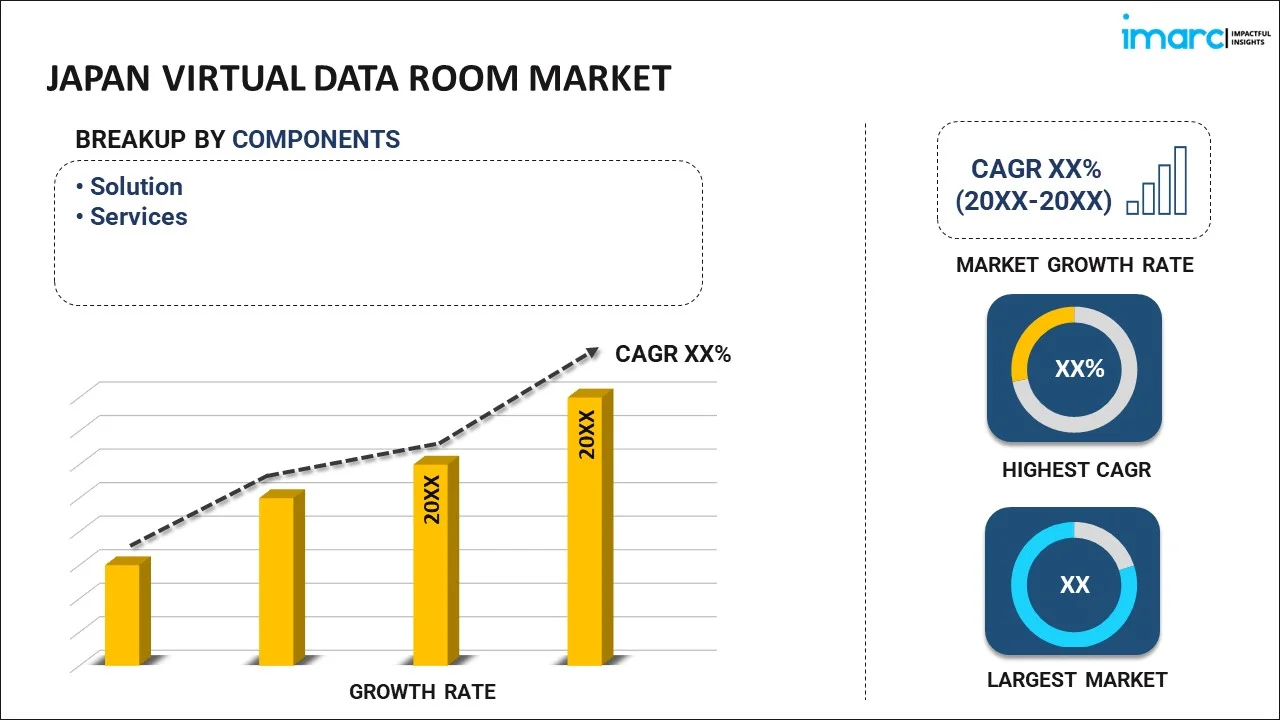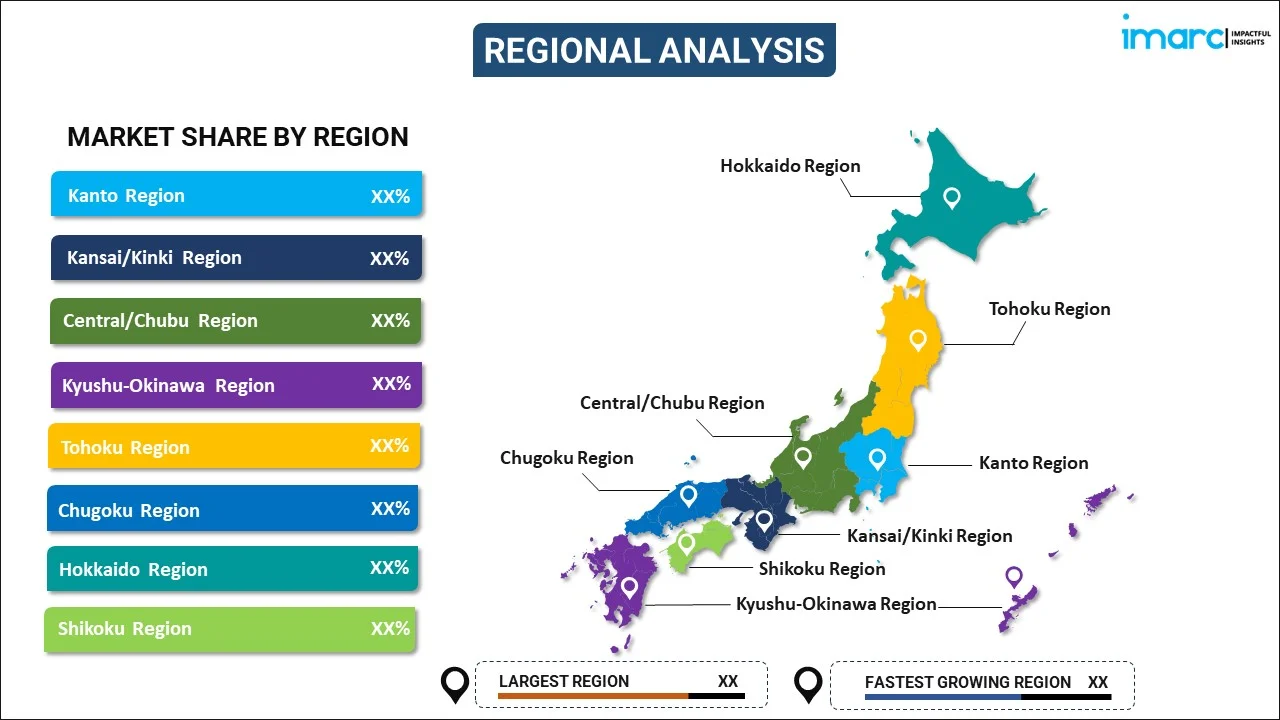
Japan Virtual Data Room Market Report by Component (Solution, Services), Deployment Type (Cloud-based, On-premises), Enterprise Size (Large Enterprises, Small and Medium-sized Enterprises), Business Function (Marketing and Sales, Legal, Finance, Workforce Management), Vertical (BFSI, Retail and E-Commerce, Government, Healthcare and Life Sciences, IT and Telecommunications, and Others), and Region 2025-2033
Market Overview:
Japan virtual data room market size reached USD 127.0 Million in 2024. Looking forward, IMARC Group expects the market to reach USD 475.6 Million by 2033, exhibiting a growth rate (CAGR) of 15.8% during 2025-2033. The growing need for real-time access of critical documents and data, rising adoption of advanced encryption, and increasing proliferation of M&As, along with an increasing number of strategic partnerships in the corporate landscape, represent some of the key factors driving the market.
|
Report Attribute
|
Key Statistics
|
|---|---|
|
Base Year
|
2024 |
|
Forecast Years
|
2025-2033 |
|
Historical Years
|
2019-2024
|
| Market Size in 2024 | USD 127.0 Million |
| Market Forecast in 2033 | USD 475.6 Million |
| Market Growth Rate (2025-2033) | 15.8% |
A virtual data room (VDR) is an online platform serving as a secure repository for storing and sharing sensitive information. It is primarily used during financial transactions, legal processes, due diligence, and other data-sensitive activities. It comprises cloud-based VDRs, which are web-hosted platforms allowing users to access data from anywhere with an internet connection. It provides a level of security that traditional file-sharing methods, such as email or physical documents, cannot match, which is crucial when dealing with sensitive financial, legal, or proprietary information. It streamlines the document management process, reducing the time and resources needed for document exchange, organization, and review. It enables seamless collaboration among teams and helps maintain transparency and ensure regulatory compliance by tracking and documenting all user interactions with data. It allows for structured data organization, making it easier to find and manage documents, which is essential for efficient business operations. It contributes to significant cost savings by reducing printing, courier, and travel costs. It plays a pivotal role in mergers and acquisitions (M&As), enabling buyers, sellers, and their advisors to exchange and review confidential financial documents, contracts, and other crucial data.
Japan Virtual Data Room Market Trends:
At present, the rising integration of advanced encryption, authentication, and audit trail features in VDRs to fortify the security of sensitive documents and data from cyber-security breaches represents one of the crucial factors impelling the growth of the market in Japan. Besides this, the increasing number of mergers and acquisitions (M&As), along with an increasing number of strategic partnerships in the corporate landscape, is catalyzing the demand for VDR solutions, as they play a pivotal role in streamlining due diligence processes and ensuring confidentiality. Additionally, ongoing digital transformation initiatives in businesses are pushing organizations to transition from traditional physical data rooms to cloud-based VDRs, as they offer greater flexibility, scalability, and cost-effectiveness. The mounting need for centralized data repositories for safekeeping and sharing of documents during business transactions, legal proceedings, and regulatory compliance processes is increasing the adoption of VDRs. Moreover, the ongoing globalization of businesses and the need to collaborate seamlessly with partners, stakeholders, and clients irrespective of geographical boundaries are propelling the market growth in the country. Moreover, the rising need for real-time access to critical documents and data is increasing the integration of artificial intelligence (AI) and machine learning (ML) technologies into VDRs, enabling features, such as automated document categorization, content search, and predictive analytics, which streamline decision-making processes and enhance user experience. Furthermore, the increasing utilization of VDRs in securely sharing research data, clinical trial results, and intellectual property in the pharmaceutical industry is bolstering the market growth in the country.
Japan Virtual Data Room Market Segmentation:
IMARC Group provides an analysis of the key trends in each segment of the market, along with forecasts at the country level for 2025-2033. Our report has categorized the market based on component, deployment type, enterprise size, business function, and vertical.
Component Insights:

- Solution
- Services
The report has provided a detailed breakup and analysis of the market based on the component. This includes solution and services.
Deployment Type Insights:
- Cloud-based
- On-premises
A detailed breakup and analysis of the market based on the deployment type have also been provided in the report. This includes cloud-based and on-premises.
Enterprise Size Insights:
- Large Enterprises
- Small and Medium-sized Enterprises
The report has provided a detailed breakup and analysis of the market based on the enterprise size. This includes large enterprises and small and medium-sized enterprises.
Business Function Insights:
- Marketing and Sales
- Legal
- Finance
- Workforce Management
A detailed breakup and analysis of the market based on the business function have also been provided in the report. This includes marketing and sales, legal, finance, and workforce management.
Vertical Insights:
- BFSI
- Retail and E-Commerce
- Government
- Healthcare and Life Sciences
- IT and Telecommunications
- Others
The report has provided a detailed breakup and analysis of the market based on the vertical. This includes BFSI, retail and E-commerce, government, healthcare and life sciences, IT and telecommunications, and others.
Regional Insights:

- Kanto Region
- Kansai/Kinki Region
- Central/ Chubu Region
- Kyushu-Okinawa Region
- Tohoku Region
- Chugoku Region
- Hokkaido Region
- Shikoku Region
The report has also provided a comprehensive analysis of all the major regional markets, which include Kanto Region, Kansai/Kinki Region, Central/ Chubu Region, Kyushu-Okinawa Region, Tohoku Region, Chugoku Region, Hokkaido Region, and Shikoku Region.
Competitive Landscape:
The market research report has also provided a comprehensive analysis of the competitive landscape. Competitive analysis such as market structure, key player positioning, top winning strategies, competitive dashboard, and company evaluation quadrant has been covered in the report. Also, detailed profiles of all major companies have been provided.
Japan Virtual Data Room Market Report Coverage:
| Report Features | Details |
|---|---|
| Base Year of the Analysis | 2024 |
| Historical Period | 2019-2024 |
| Forecast Period | 2025-2033 |
| Units | Million USD |
| Scope of the Report | Exploration of Historical Trends and Market Outlook, Industry Catalysts and Challenges, Segment-Wise Historical and Future Market Assessment:
|
| Components Covered | Solution, Services |
| Deployment Types Covered | Cloud-based, On-premises |
| Enterprise Sizes Covered | Large Enterprises, Small and Medium-sized Enterprises |
| Business Functions Covered | Marketing and Sales, Legal, Finance, Workforce Management |
| Verticals Covered | BFSI, Retail and E-Commerce, Government, Healthcare and Life Sciences, IT and Telecommunications, Others |
| Regions Covered | Kanto Region, Kansai/Kinki Region, Central/ Chubu Region, Kyushu-Okinawa Region, Tohoku Region, Chugoku Region, Hokkaido Region, Shikoku Region |
| Customization Scope | 10% Free Customization |
| Post-Sale Analyst Support | 10-12 Weeks |
| Delivery Format | PDF and Excel through Email (We can also provide the editable version of the report in PPT/Word format on special request) |
Key Questions Answered in This Report:
- How has the Japan virtual data room market performed so far and how will it perform in the coming years?
- What has been the impact of COVID-19 on the Japan virtual data room market?
- What is the breakup of the Japan virtual data room market on the basis of component?
- What is the breakup of the Japan virtual data room market on the basis of deployment type?
- What is the breakup of the Japan virtual data room market on the basis of enterprise size?
- What is the breakup of the Japan virtual data room market on the basis of business function?
- What is the breakup of the Japan virtual data room market on the basis of vertical?
- What are the various stages in the value chain of the Japan virtual data room market?
- What are the key driving factors and challenges in the Japan virtual data room?
- What is the structure of the Japan virtual data room market and who are the key players?
- What is the degree of competition in the Japan virtual data room market?
Key Benefits for Stakeholders:
- IMARC’s industry report offers a comprehensive quantitative analysis of various market segments, historical and current market trends, market forecasts, and dynamics of the Japan virtual data room market from 2019-2033.
- The research report provides the latest information on the market drivers, challenges, and opportunities in the Japan virtual data room market.
- Porter's five forces analysis assist stakeholders in assessing the impact of new entrants, competitive rivalry, supplier power, buyer power, and the threat of substitution. It helps stakeholders to analyze the level of competition within the Japan virtual data room industry and its attractiveness.
- Competitive landscape allows stakeholders to understand their competitive environment and provides an insight into the current positions of key players in the market.
Need more help?
- Speak to our experienced analysts for insights on the current market scenarios.
- Include additional segments and countries to customize the report as per your requirement.
- Gain an unparalleled competitive advantage in your domain by understanding how to utilize the report and positively impacting your operations and revenue.
- For further assistance, please connect with our analysts.
 Inquire Before Buying
Inquire Before Buying
 Speak to an Analyst
Speak to an Analyst
 Request Brochure
Request Brochure
 Request Customization
Request Customization




.webp)




.webp)












